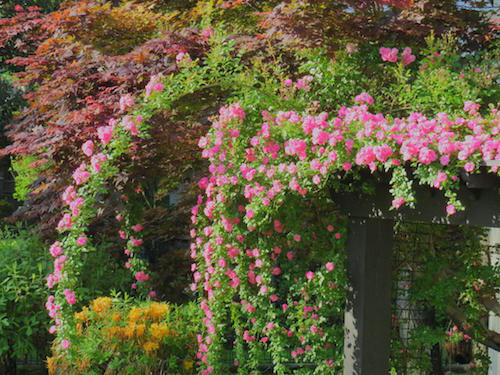
The Peggy Martin rose is a remarkable sight in the spring.
March 20, 2024 - In the world of roses, few cultivars captivate the heart and soul quite like the Peggy Martin rose. This remarkable rambler, born from tragedy and triumph, has captured the admiration of gardeners worldwide with its resilience, vigor, and spring beauty.
The Peggy Martin rose, also known as the "Katrina rose," rose from the devastation wrought by Hurricane Katrina in 2005. Named after Peggy Martin, a South Louisiana gardener who lost her home, garden, and elderly parents to the storm, this rose miraculously survived the salty floodwaters that submerged her property for weeks. Despite facing seemingly insurmountable odds, the Peggy Martin rose emerged from the wreckage as a symbol of hope and resilience. Friend, Peggy is a mainstay in the rose world, and I have had the pleasure of being on programs with her before and visited her home and rose garden in Gonzales, Louisiana when I was giving a program for the New Orleans Old Garden Rose Society.
Peggy originally collected the “pass-a-long” rambling rose in New Orleans where according to Dr. Welch, Peggy she was given cuttings of the thornless climber in 1989 by Ellen Dupriest who had gotten her rose cuttings from her mother-in-law, Faye Dupriest. Faye had gotten her cuttings from a relative's garden in New Orleans. Peggy then shared cuttings with my mentor, co-author, and now retired Texas A&M AgriLife Extension landscape horticulturist Dr. William C. Welch who named it and introduced it to both the public and the nursery industry.
One of the defining characteristics of the Peggy Martin rose is its vigorous growth and abundant blooms. This climbing rose can reach heights of up to twenty feet, adorning arbors, fences, and trellises with cascades of delicate pink spring blooms. Although not at spectacular, it can also make a repeat performance in the fall which is unusual for rambling roses, most being once bloomers in the spring.
What sets the Peggy Martin rose apart from many roses is its remarkable adaptability to adverse growing conditions. This rose thrives in a wide range of climates, from the hot and humid summers of the Deep South to the cooler temperatures of the Northeast. It is highly resistant to pests and diseases, making it an ideal choice for low-maintenance landscapes and beginner gardeners.
The versatility of the Peggy Martin rose makes it a valuable addition to any garden landscape. Whether trained to climb a trellis, cascade over a fence, or sprawl along a garden wall, this rose adds vertical interest and visual appeal to any outdoor space. Its long, flexible, thornless canes can be trained to weave through arbors and pergolas, creating a romantic and picturesque backdrop for outdoor gatherings and celebrations.
More than just a beautiful flower, the Peggy Martin rose serves as a testament to the indomitable spirit of gardeners and the power of nature to overcome adversity. Planted in gardens around the world, it stands as a symbol of hope, resilience, and the enduring beauty of the human spirit.
Greg Grant is the Smith County horticulturist and Master Gardener coordinator for the Texas A&M AgriLife Extension Service. He is the author of Texas Fruit and Vegetable Gardening, Texas Home Landscaping, Heirloom Gardening in the South, and The Rose Rustlers. You can read his “Greg’s Ramblings” blog at arborgate.com, read his “In Greg’s Garden” in each issue of Texas Gardener magazine (texasgardener.com), or follow him on Facebook (“Greg Grant Gardens”) and Instagram (“ggrantgardens”). More science-based lawn and gardening information from the Texas A&M AgriLife Extension Service can be found at aggieturf.tamu.edu and aggie-horticulture.tamu.edu.








